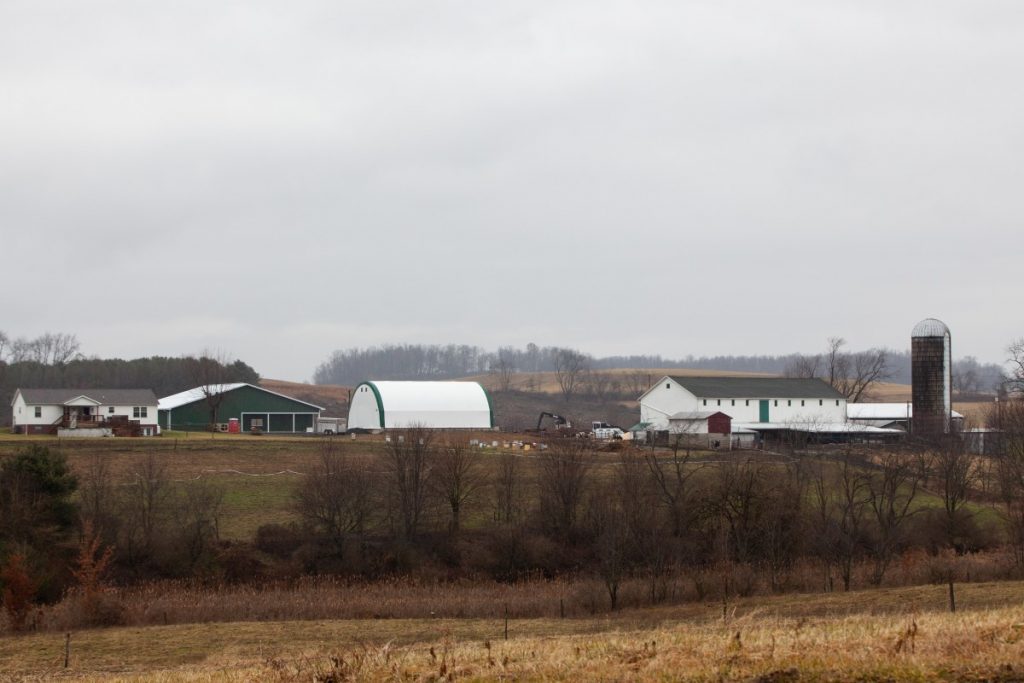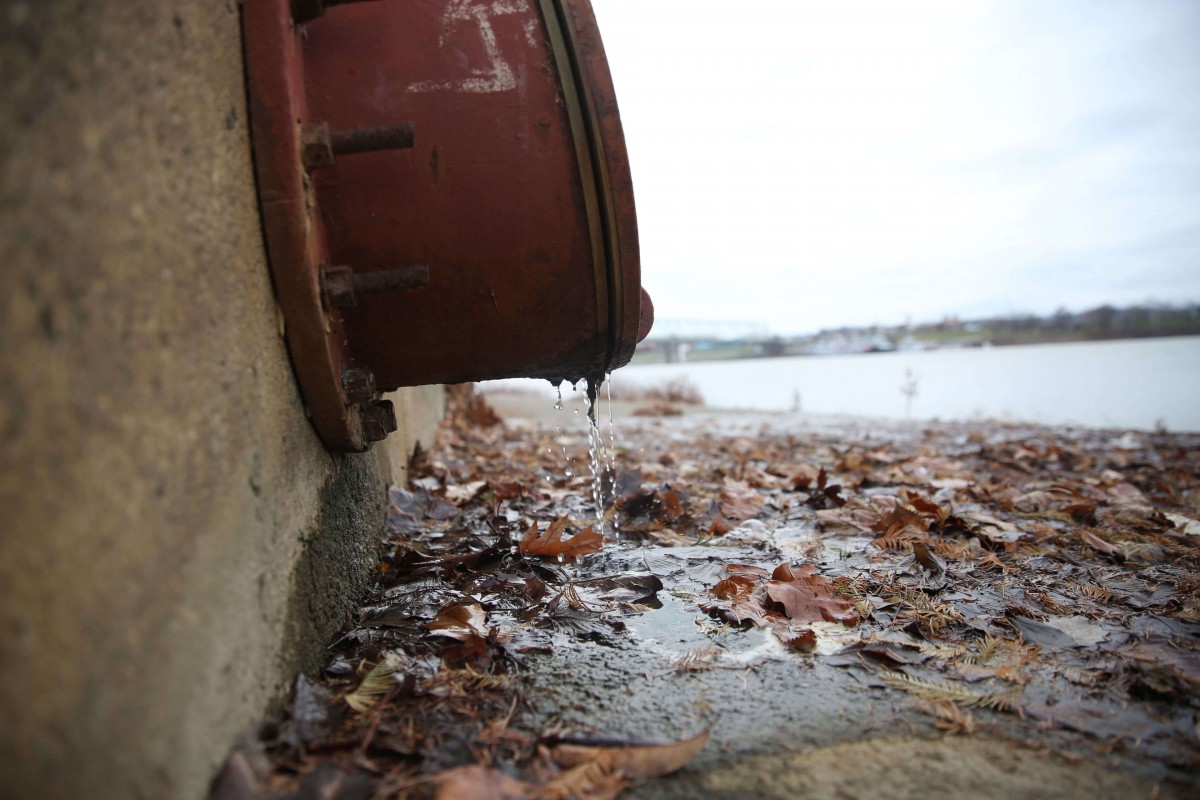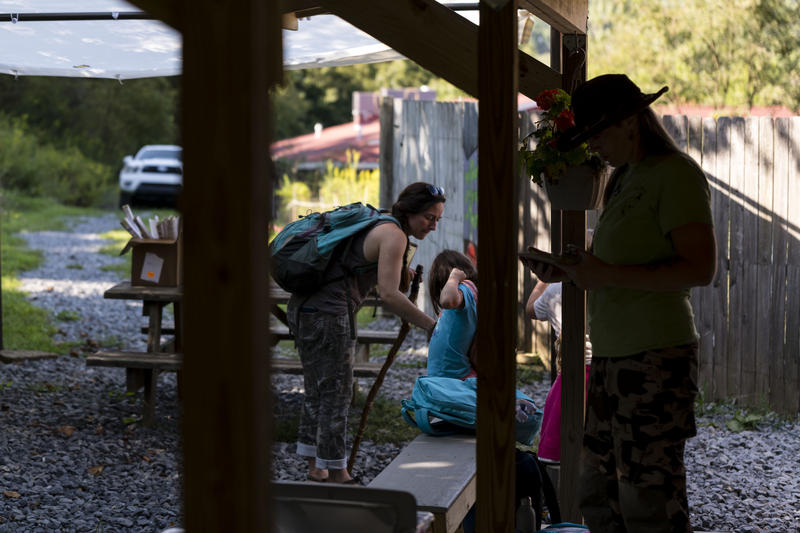Cara Stephenson carefully navigates the short, well-worn path that begins at her grandparents’ back door and drops down a gentle slope before ending at the milking barn. It’s muddy and slick this time of year, saturated with fall rain and melting snow and rutted by the repeated pounding of work boots.
It’s the same path five generations have been walking since 1795 when Stephenson’s great-great-grandparents purchased the 160-acre plot of land along Center Drive in Butler County, Pennsylvania, and made it a farm.
In more than 200 years, that farm has been a lot of things: a place to grow potatoes and breed racehorses and raise cattle. But, for nearly a century now, it’s been Moser’s Dairy, an operation known for its 80 head of prize-winning Guernseys, a hardy, docile breed with distinctive fawn-and-white coloring.
Milking them is not an easy business. At Moser’s, mornings begin at 4. Evenings end after dark or not at all when a calf is coming. There are no vacations, no sick days.
“You don’t hang a sign up when it comes Christmas or New Year’s,” said Jim Moser, Stephenson’s grandfather and the farm’s current owner.

At 86 and beset by heart issues, Moser is mostly retired, but for decades, he was the one rising before dawn, milking the cows, bottling the product and driving a familiar loop around the county to deliver fresh jugs.
He likes things done the traditional way, so his children and grandchildren still use a bucket milking system and his wife, Dixie, keeps track of expenses by hand. Thanks to her off-the-farm job at Koppers, a local chemical company, and her meticulous bookkeeping, the farm has never been in debt.
Dixie would like to keep it that way, but in today’s economy, that likely means shutting the dairy down. Jim wants to keep milking for as long as the money will let them.
Out in the milking barn, Stephenson sweeps her eyes over the lazing Guernseys– each of which has its own name and personality– and considers the options.
“I’ve been in this barn since I was two days old,” she said. “Us grandkids would love the dairy to go on.”
She pauses and recalculates.
“If we can overcome the problems, we’d love it to go on.”
The troubles in the dairy industry, not just in Appalachia, are numerous and growing. Prices, which have historically followed a three-year cycle, have been low for more than four years now thanks to a global milk glut, requiring many farmers to dip into savings or equity to stay afloat. The down market is scaring off the next generation of farmers, who see more stability and potential wealth in working off the farm. As they opt out, farms are forced to close. And as the farms disappear, the infrastructure around them — large animal veterinarians and equipment suppliers, for example — collapses, making it more difficult for the remaining farms to operate.
“It’s a cumulative challenge,” said Andrew Sandeen, a Penn State Extension dairy educator.
And it’s a challenge to which farms across the nation are increasingly succumbing. According to the United States Department of Agriculture, the country has lost more than 17,000 dairy farms in the past decade. Dean Foods, the nation’s largest milk producer, recently filed for bankruptcy protection citing a decline in dairy consumers.

Pennsylvania, which ranks sixth in the nation in total milk production, milked 25,000 fewer cows and produced 5.5 percent less milk in the past year alone and had the unfortunate distinction of ranking second in the nation in number of farms lost. Pennsylvania lost lost 370; Wisconsin lost 590.
But the state does have at least one unique advantage. It ranks second-to-last in average herd size, behind only Rhode Island. Those small, family-owned operations that pepper the western half of the state tend to be nimbler than their thousand-herd counterparts in the Midwest, theoretically allowing them to adapt and evolve with greater ease, attempting unconventional or value-added ventures that may help to keep them afloat.
“It’s tough to dig out of the hole and be optimistic about the future,” Sandeen said. “But Western Pennsylvania comes about as close as anywhere to fitting that idealistic farm picture our society has, and I think there’s potential in that.”
‘Close Your Eyes and Jump off the Deep End’
Economics on a small dairy farm are stark.

In Western Pennsylvania, a typical family farm will milk about 50 cows, and each one will produce about 20,000 to 23,000 pounds (before bottling, milk is measured in pounds, not gallons) of milk per year, depending on farm practices and cattle breed.
In the current market, an area farmer can expect to make about $17 to $18 per hundred pounds. It all sounds viable until you consider the expenses: feed, vet bills, tractors, milking equipment, machinery upkeep. In a bad year, the profits may not cover the costs.
“It’s the impossible industry,” said Jason Frye, whose family owns Pleasant Lane Farms in Westmoreland County, situated directly west of Pittsburgh. “There’s no good reason anyone should be milking cows.”
Which makes Frye’s return to the farm after 20 years of working in Washington, D.C., that much more implausible.

Frye and his brothers, Todd and Chad, labored alongside their father, Ralph, a sixth-generation dairy farmer, when they were teenagers. But as soon as they were able, each chose his own path. Jason turned to tech, Todd joined the National Guard and Chad took a job in manufacturing.
Their off-the-farm work is more stable and less taxing, but their roots are still firmly planted in the ground at Pleasant Lane. So when the dairy industry took its troubling turn four years ago, instead of digging deeper into their chosen careers, they devised a bold plan to circumvent industry weaknesses and revive the ailing family business.
They’re going to make cheese.
“Cheese actually makes real money that can support the family,” Frye said. “But the problem is you have to close your eyes and jump off the deep end.”

This summer, they did just that. With the help of a $364,000 grant from the Pennsylvania Dairy Investment Program, the Fryes are building a 5,000-square-foot facility that will house a creamery, half a million dollars worth of equipment, a learning laboratory and, eventually, a robotic milking system.
When the facility is up and running in late February or early March, the family will begin devoting 20 percent of their milk to cheesemaking– the remaining 80percent will continue being shipped to Turner Dairy Farms in Penn Hills for fluid processing. But Jason Frye predicts that 20percent will be much more lucrative, returning about $90 per hundred pounds instead of $17. As the creamery grows, they’ll devote more and more of their milk to cheesemaking.
“The goal,” said Frye, “is to get to 100 percent.”
If that happens, they’ll be able to count the gains in hundreds of thousands of dollars.
Pleasant Lane’s grand experiment will begin with six cheeses, including curds, gouda, aged cheddar and quark, which has the consistency of Greek yogurt and will be spiked with honey from the farm’s apiary. Eventually, family matriarch Ann Frye will add cheesecakes, filled with fresh, farm-grown berries, to the product line and a full-time employee will join the team to help process products for other local dairies.
But for all of the excitement about cheese, it’s the robotic milking system that could be the true difference maker.
The smallest and most traditional dairy farms employ a relatively inexpensive bucket milking system, where the milk flows from the cow into a stainless steel drum that must then be emptied into a bulk tank. Today, most farms in Western Pennsylvania use pipeline milkers that carry milk directly from the cow to a bulk tank.

But both systems require that cows be milked at least twice a day, a process that takes hours of labor. Once Pleasant Lane Farms has its robotic system in place, the cows will decide when they want to be milked, entering and exiting the system on their own, grazing in the fields freely, letting the family focus on other operations and, perhaps, allowing them to increase the size of the herd. Eventually, they’d like to milk 65 cows instead of the current 45, expanding milk production and profits.
The venture is a gamble, if a well-calculated one, but Jason Frye says it is also a necessity if the family wants Pleasant Lane Farms to survive.
“It was basically do this or go home,” he said.
‘It’s Hard to Imagine Getting Out’

Back in Butler County, Jim and Dixie Moser settle into chairs at their dining room table. Their home is timeworn and cozy, surfaces covered in newspaper clippings and photographs of their grandchildren. Every night, the extended family gathers inside to eat a meal that Dixie and her daughter prepare.
It’s an idyllic existence, but one that the family knows could fall into economic peril with any further dip in dairy prices. And they admit that, save for selling gas and oil rights, viable solutions for the operation have been hard to come by. At 86 and 87, Jim and Dixie say they’re too old to produce niche, value-added products, like cheese, ice cream, or bottled milk. They stopped the time-intensive practice of jugging their own milk years ago and now sell to United Dairy in Ohio.
Growing the Guernsey herd — a solution often offered by the uninitiated — is a futile endeavor, akin to “cutting your own throat,” Jim says, noting the increased facility, feed and labor costs that would outstrip any profits.
But shuttering the farm means not only cleaving off the only revenue source for two of their four children and three of their four grandchildren but also abandoning a centuries-old tradition that has become inextricably entangled with their family identity.

“For people who have worked for themselves in an industry they love for their entire lives, it’s hard to imagine getting out,” dairy educator Sandeen said.
But all around the Mosers, the unimaginable keeps happening. Butler County had 396 dairy farms in 1969. Today, there are just 26.
The price of milk is, of course, the leading culprit, but Jim Moser believes there’s an underlying issue that’s just as troubling.

“The general public doesn’t understand agriculture,” he said. “They have no idea because they’re too far removed. Agriculture is the most important industry in this world. If you don’t have food, there’s a whole lot of other things you’re not going to need.”
It’s a lesson granddaughter Stephenson attempts to impart in her role as the chair of the Butler County Dairy Promotion Team. The 50-year-old organization’s mission is to educate the public about the dairy industry, and its central message is a familiar refrain: Buy local.
Purchasing milk produced by local processors in Western Pennsylvania, like United, Turner, Marburger and Schneider, or looking for a plant label that begins with the number 42 ensures that the milk came from a local dairy and that the money will stay in the region.

At Pleasant Lane, the Fryes are doing their part by working with the state’s Center for Dairy Excellence on programming designed to reconnect the public to its food source. They will offer educational tours for area students and cheesemaking classes for prospective cheesemongers in the creamery’s learning laboratory, capitalizing on the farm-to-table trend — “People just want to see how the cheese is made,” Todd Frye quips — and creating another possible revenue stream.
Whether messages or methods like these will slow the region’s hemorrhaging of dairy farms is unknown, but the Mosers and Fryes are willing to bet that inviting the public to share in family lore and tradition is at least enough to inspire loyalty.
“That’s why you build the story,” Jason Frye said.
April Johnston is an award-winning freelance writer and podcaster based in Pittsburgh. Contact her through her sites apriljohnston.net and nebbypittsburgh.com.



